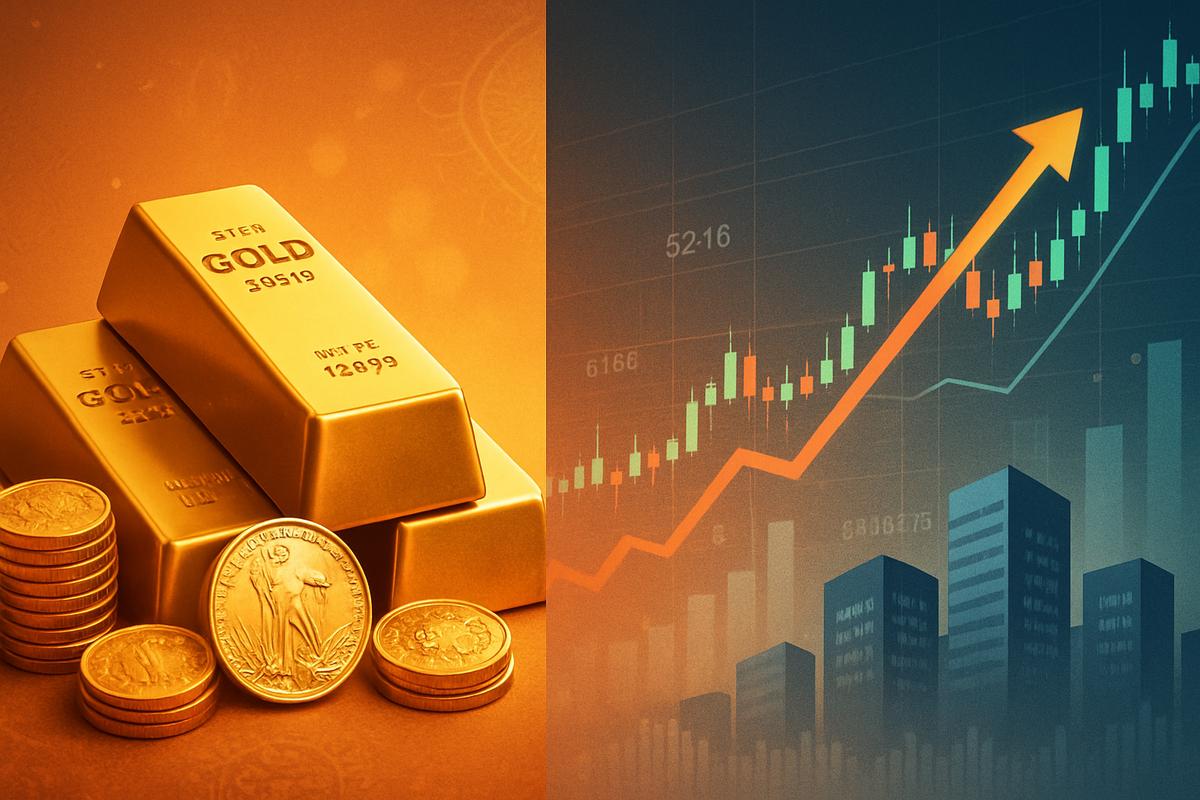
As the festive season of Diwali approaches in 2025, investors across India and globally are once again contemplating a timeless financial dilemma: will the glimmer of gold or the dynamism of the stock market deliver greater prosperity and happiness by the next festival of lights? With gold having experienced an extraordinary rally and Indian equities poised for a potential resurgence, the choice for wealth creation in the coming year is more nuanced than ever.
The current financial landscape is a tapestry woven with threads of cautious optimism and persistent global uncertainties. While a "risk-on" sentiment has notably returned to global markets, signaling growing confidence in equities, geopolitical tensions continue to provide a strong undercurrent of safe-haven demand, propelling gold to unprecedented highs. This comparative analysis delves into the recent trajectories, future prospects, and underlying economic factors influencing both gold and stocks, aiming to illuminate the path for investors seeking optimal returns by Diwali 2026.
A Tale of Two Markets: Gold's Record Run and Equities' Anticipated Ascent
The period leading up to Diwali 2025 has seen a remarkable divergence in the performance of these two key asset classes. Gold has been the undisputed champion of the short term, surging over 60% in USD terms in 2025 and an impressive 62.6% in INR terms since the last Dhanteras. This extraordinary rally is attributed to a potent cocktail of factors: heightened safe-haven demand amidst geopolitical instability in regions like the Middle East and Eurasia, persistent economic uncertainties, aggressive buying by central banks globally, robust inflows into Exchange Traded Funds (ETFs), and expectations of U.S. interest rate cuts. Gold prices have comfortably breached records, trading above $4,200 USD per ounce.
In contrast, the Indian stock market, represented by bellwether indices like the Sensex and Nifty 50 (NSEI: NIFTY), has experienced a period of consolidation over the past twelve months, delivering more moderate returns—the Nifty 50 saw approximately 6-6.7% since the last Diwali. This performance was tempered by global economic uncertainties, ongoing geopolitical tensions, and capital outflows from foreign investors, partly due to tariff-related concerns. However, the narrative for Indian equities is shifting, with a decidedly bullish sentiment building for the new Hindu financial year, Samvat 2082.
The economic outlook for India is a significant driver of this optimism. The International Monetary Fund (IMF) has increased India's GDP growth projection for 2025 to 6.6%, a revision reflecting a strong first quarter. The Reserve Bank of India (RBI) has also raised its FY26 GDP growth forecast to 6.8%, citing low inflation and robust corporate and bank balance sheets. India's retail inflation has significantly cooled, reaching an eight-year low of 1.54% in September 2025, providing the RBI with flexibility for monetary policy easing. While the repo rate was held at 5.5% in October 2025, a potential 25-basis-point rate cut in December is on the horizon, shifting the RBI's focus towards supporting economic growth. Despite these domestic strengths, global geopolitical risks, including escalating conflicts, rising protectionism, and US-China trade tensions, remain elevated, posing potential threats to global financial stability and market volatility.
Corporate Fortunes: Winners and Losers in the Asset Tug-of-War
The ongoing debate between gold and stocks as preferred investment avenues creates distinct opportunities and challenges for various public companies. A sustained preference for gold, driven by safe-haven demand, generally benefits companies involved in gold mining, refining, and jewelry retail. Gold mining companies, such as Barrick Gold Corporation (NYSE: GOLD) or Newmont Corporation (NYSE: NEM), would see increased revenues and profitability as gold prices remain elevated. Similarly, jewelers like India's Titan Company Limited (NSEI: TITAN) or global luxury brands, while subject to broader consumer sentiment, often experience a boost in sales during periods of high gold prices, especially around festive seasons like Diwali. However, if investors shift aggressively from equities to gold, it could signal broader economic distress, which might eventually dampen even luxury gold consumption.
Conversely, a resurgence in equity markets, fueled by India's robust economic outlook and anticipated corporate earnings growth, stands to significantly benefit a wide array of public companies. Sectors such as Auto, Banking, and Non-Banking Financial Companies (NBFCs) are particularly well-positioned for outperformance. Companies like Hyundai Motor Company (KRX: 005380), a major player in the auto sector, could see increased demand driven by improved consumer sentiment and disposable income. Indian banking giants such as HDFC Bank Limited (NSEI: HDFCBANK) and ICICI Bank Limited (NSEI: ICICIBANK) are expected to thrive from lower interest rates, increased credit demand, and robust corporate balance sheets. NBFCs, including Mahindra & Mahindra Financial Services Limited (NSEI: M&MFIN), are also set to benefit from an expanding credit market and economic growth.
Furthermore, companies involved in infrastructure and manufacturing, such as Reliance Industries Limited (NSEI: RELIANCE) and Power Finance Corporation Limited (NSEI: PFC), are likely to gain from continued government reforms and investment in economic development. The anticipated boost in domestic consumption, spurred by RBI rate cuts and tax relief, would broadly support consumer discretionary companies. However, a significant rotation of capital out of equities and into gold could lead to downward pressure on stock valuations across the board, even for fundamentally strong companies, as liquidity tightens and investor confidence in riskier assets wanes. The interplay between these two asset classes, therefore, directly impacts the perceived value and future prospects of companies across various sectors.
Broader Implications: Navigating Macroeconomic Currents and Geopolitical Tides
The comparative performance of gold and stocks by Diwali 2025 is deeply intertwined with broader industry trends, macroeconomic shifts, and geopolitical dynamics. The recent surge in gold prices fits into a global trend of increased demand for safe-haven assets amidst persistent global uncertainties. This includes ongoing conflicts, rising nationalism, protectionism, and the enduring trade tensions between the US and China. These factors create an environment where investors seek refuge from volatility, traditionally finding it in gold. This trend can have ripple effects, potentially diverting capital from emerging markets and growth-oriented sectors into more defensive assets globally.
For the Indian market, the strong domestic economic indicators, such as cooling inflation, robust GDP growth projections, and potential interest rate cuts by the RBI, position equities for a significant upswing. This aligns with a broader trend of emerging markets, particularly India, becoming attractive destinations for foreign capital seeking growth. However, this optimism is tempered by external vulnerabilities. While India is actively pursuing market diversification strategies to mitigate the impact of potential tariffs, especially from the US, global trade disruptions could still affect export-oriented sectors and overall market sentiment.
Historically, gold has often served as a hedge against inflation and currency depreciation, while stocks have been primary drivers of long-term wealth creation during periods of economic expansion. The current scenario presents a unique confluence: low domestic inflation in India, typically supportive of equities, alongside global inflationary pressures and geopolitical risks that bolster gold. This creates a complex environment where traditional correlations might be tested. Regulatory or policy implications could also emerge; for instance, any government moves to encourage or discourage gold imports or investments could directly impact its market dynamics, while continued reforms in corporate governance or taxation could further enhance the attractiveness of Indian equities. The balance between these forces will dictate which asset class ultimately delivers superior returns and investor satisfaction.
The Road Ahead: Scenarios and Strategic Pivots
Looking towards the next Diwali, the investment landscape for gold and stocks presents several potential scenarios and strategic considerations for investors. In the short term, some market analysts anticipate a temporary dip in gold prices immediately following Diwali. This potential slowdown is attributed to a post-festive decrease in demand and a possible normalization of certain geopolitical situations, such as progress in trade talks or de-escalation of conflicts. Such a dip could be viewed as an opportune moment for long-term gold investors to accumulate the precious metal, treating it as a strategic diversifier rather than a primary growth driver. HSBC and ANZ, for instance, project gold prices to remain elevated, with potential to reach $5,000 per ounce in 2026, driven by persistent geopolitical risks and economic policy uncertainty.
For stocks, particularly Indian equities, the long-term outlook appears robust. The bullish sentiment for Samvat 2082 is underpinned by several key factors: a projected revival in corporate earnings, expected to reach double digits from the December 2025 quarter and accelerate through FY27 and FY28; macroeconomic tailwinds such as subdued crude oil prices and favorable outcomes from potential US-India trade deals; and domestic boosters like RBI repo rate cuts, GST rationalization, and personal income tax relief, all anticipated to significantly boost domestic consumption. This suggests a potential shift of global capital from safe havens to emerging markets like India, creating market opportunities for investors willing to take on more risk for higher growth potential.
Investors may need to consider strategic pivots. For those heavily invested in gold, a rebalancing towards Indian equities might be prudent, especially if the anticipated post-Diwali dip materializes. Conversely, equity investors should remain vigilant to global geopolitical developments, as any significant escalation could trigger renewed safe-haven flows into gold. The emergence of new market opportunities in specific sectors, such as Auto, Banks, and NBFCs, identified by leading brokerages, suggests that selective stock picking within a diversified equity portfolio could yield substantial returns. The next twelve months will likely be characterized by a dynamic interplay between global risk factors and India's strong domestic growth narrative.
A Balanced Perspective: Key Takeaways for the Astute Investor
As Diwali 2025 fades into memory, the investment journey towards the next festive season will be shaped by a complex interplay of global and domestic factors. The key takeaway from the current analysis is that while gold has delivered exceptional short-term returns due to its safe-haven appeal, its aggressive rally's upside might be limited going forward. For investors with a long-term horizon (three years or more), historical data and current economic projections strongly favor equities, particularly Indian stocks, for superior wealth creation. A comprehensive study spanning 35 years (1990-2025) by OmniScience Capital, for instance, reveals that the Sensex delivered an average annual rolling return of approximately 11.5%, outperforming gold's 9.5%, with the Nifty50 consistently providing superior returns over longer holding periods.
Moving forward, the Indian stock market is poised for a robust performance, driven by a positive economic outlook, anticipated corporate earnings growth, and supportive policy measures. Subdued inflation, potential interest rate cuts by the RBI, and government reforms are expected to fuel domestic consumption and corporate profitability. Gold, while a valuable component of a diversified portfolio, is best viewed as a strategic diversifier against unforeseen global shocks rather than the primary engine of growth. Investors are advised against aggressive accumulation of gold at current high levels, though any post-Diwali dip could present an attractive entry point for long-term, diversified holdings.
In the coming months, investors should closely watch for continued signs of corporate earnings revival, the RBI's monetary policy decisions, the trajectory of global geopolitical events, and any shifts in foreign institutional investor flows. The ability to adapt portfolios to these evolving conditions, maintaining a balance between growth-oriented equities and strategically held safe-haven assets, will be crucial. Ultimately, while cultural traditions may favor gold purchases during Diwali, a strategic, data-driven investment approach that emphasizes Indian equities for long-term wealth accumulation, complemented by a prudent allocation to gold for diversification, is likely to bring greater financial happiness by the next Diwali.
This content is intended for informational purposes only and is not financial advice





